Receive Focus insights straight to your inbox
South Africa's GDP grew by 4.6% on a quarter on quarter seasonally adjusted annualised (qqsaa) basis in the first quarter of 2021, notably ahead of consensus expectations of 3.2% qqsaa. This followed Q4.20’s 5.8% qqsaa (revised) lift.
The second wave of Covid-19 infections prompted government to tighten lockdown restrictions towards the end of Q4.20. Accordingly, certain sectors of the economy were unable to trade optimally.
Restrictions were eased modestly in February and at the beginning of March level one was again reinstated, inducing a pickup in a activity.
A strong rebound in global growth, which is anticipated at 6.0% this year (IMF projection), has supported the significant uptick in commodity demand, aiding commodity exporting nations like South Africa.
This, coupled with the vaccine rollout, which should boost sentiment going forward, is expected to underpin growth of 3.9% this year.
Risks to this outlook however remain, including delays in vaccinating the population and, importantly, electricity supply constraints, with heightened rotational loadshedding a key hindrance to growth.
Listen: Annabel Bishop on SA's Q1 GDP figures
Investec Chief Economist Annabel Bishop speaks to TimesLive about how an uptick in consumer spending and the performance of the mining and financial services industries have bolstered South Africa’s growth prospects.
A sectoral breakdown of the GDP outcome indicates that the mining and finance sectors were largely responsible for the 4.6% qqsaa headline lift. Mining and quarrying grew by 18.1% qqsaa and finance by 7.4% qqsaa, collectively adding a combined 2.7% points to the topline result.
The mining sector’s robust performance, underpinned by the rebound in global commodity demand, boosted the primary sector of the economy by 11.9% qqsaa. This despite the agricultural sector (including forestry and fishing) contracting by -3.2%, weighed down by diminished production of animal products and field crops.
Following its 13.1 y/y gross value added expansion in 2020, the agricultural sector is still poised for a another favourable year, supported, according to Agbiz, “by favourable rainfall and expansion in plantings”.
Following expansion of 16.9% qqsaa in Q4.20, the secondary sector of the economy grew by just 1.0% in the first quarter of 2021. Manufacturing sector activity, which made the largest positive contribution to GDP in Q4.20 (2.4% points, on the back of growth of 21.1% qqsaa), slowed to a modest 1.6% qqsaa in Q1.21. Numerous challenges continue to plague the industry, including raw material shortages underpinned by global supply chain constraints and loadshedding as a result of power shortages.
Electricity, gas and water production fell by 2.6%, while construction activity rose by a marginal 0.8%, versus a robust 11.2% qqsaa previously.
The tertiary economy grew by 4.6% qqsaa, buoyed by the finance industry, which makes up the largest share of GDP. While the trade sector still contributed a meaningful 0.8% points to the headline outcome in Q1.21, its growth rate eased to 6.2% qssaa from 9.8% qqsaa in Q4.20. In response to the second wave government implemented harsher lockdown measures, hurting the catering and accommodation sectors during the important holiday period.
Household consumption expenditure grew by a further 4.7% qqsaa, contributing 3.0% points, with spending on clothing and furnishings up by 22.2% and 8.9% respectively.
While consumer confidence has edged up from historic lows recorded in the second quarter of last year, it remains subdued. Consumers continue to face financial uncertainty, with the official unemployment rate rising to 32.6% in Q1.21, the highest rate since the commencement of the quarterly labour force survey in 2008 (which records changes in unemployment on a quarterly basis).
Gross fixed capital formation fell by -2.6% qqsaa in the first quarter of 2021, shaving -0.4% points from the topline GDP outcome, largely as a result of a decline in the machinery and equipment category. Going forward, however, construction activity should gain momentum from Government’s planned large-scale infrastructure development drive.
To boost sentiment and place South Africa on a path to sustainable growth, it remains imperative that the country accelerate the rollout of its Covid-19 vaccination programme. Equally critical are the need to increase the supply of electricity and water, improve capacity at ports and and address other areas of flagging state infrastructure and systems.




